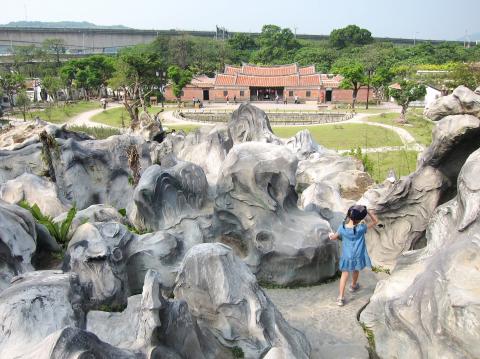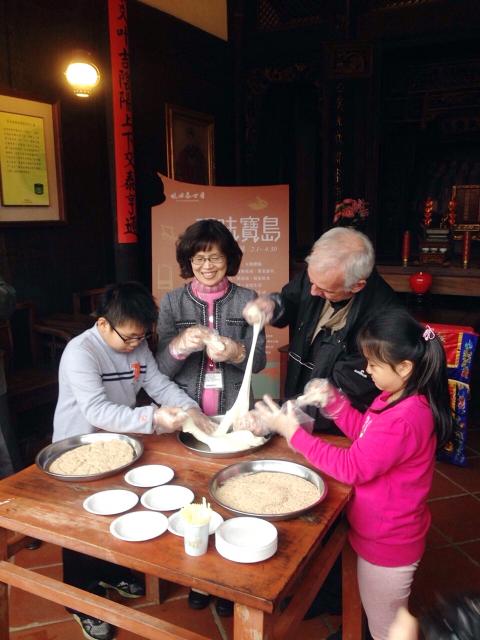Oct. 9 to Oct. 15
The windows and furniture went first, then each roof tile, truss, brick and finally the stone floor panels. In November of 1978, the then-195 year old Lin An Tai Old House (林安泰古厝) was gone — but not demolished.
Luckily, the government’s decision to remove the house came during a time when historic preservation was becoming a hot topic. Instead of razing the house, all parts were carefully labeled and numbered so it could one day be put together again.

Photo: Lin Hsiang-mei, Taipei Times
However, since it was the first undertaking of its kind in Taiwan, things did not go as smoothly as anticipated, and the 10km move to its new site took 10 years to complete, with only a third of the original courtyard compound rebuilt.
Perhaps environmental activist and current Taipei Clean Government and Transparency Commission (台北市廉政透明委員會) member Ma Yi-kung (馬以工) was right: after the plan was unveiled on Oct. 11, 1977, she wrote in the book, Goodbye Lin An Tai (再見林安泰), that “there is no way the entire house could be restored to its former glory with such a hasty plan.”
SAVING HISTORY

Photo: Lin Hsiang-mei, Taipei Times
Lee Chia-lin (李家琳) writes in the book, Introduction to Cultural Heritage and its Regulations (文化資產概論與法規) that the the Chinese Nationalist Party (KMT) completely ignored historic preservation when it first arrived, their main focus was to solidify their rule and focus on economic development.
Rapid industrialization and urbanization in the 1950s and 1960s led to the destruction of countless historic sites, which alarmed many scholars. Since the KMT was only concerned with promoting Chinese culture, Lee writes that preservationists argued that historic buildings were built by people who originally came from China and thus were worthy of attention.
The “movement” to save old buildings took off in the 1970s, with notable events such as the restoration of the Lin Family Garden and the successful resistance to the government’s attempt to raze the Changhua Confucius Temple.

Photo courtesy of Taipei City Government Department of Civil Affairs
Ma was actually elated when she first heard in 1976 that the government was planning to move the Lin An Tai house to the planned Taipei Zoo in order to extend Dunhua South Road (敦化南路) to meet Heping East Road (和平東路).
“We’ve been too used to seeing old houses replaced by modern apartments,” she writes in the book. “At least this shows that society is now paying attention to cultural progress and historical value.”
But when she met with the Taipei City Government to discuss the plans in March 1977, she realized that there was no plan, nor were the officials confident that they could pull off the relocation.
This news garnered the attention of scholars, historians and cultural experts, who all made attempts to stop the government. Of course, there was also a camp who advocated modernization and removal of all things old. The city officials argued that since the house was not listed among Taipei’s official historic sites, it did not have legal protection.
Ma and the other scholars were furious. They later learned that the building was indeed surveyed during the making of the list in 1973, but since it was already in the way of the planned Dunhua South Road extension, the city government intentionally left it out.
After much back and forth over the following few months, the final decision came down for the building to be removed by the end of October 1978.
“It was such a joke,” Ma writes. “The ‘plan’ was a three-page document mostly describing the house and introducing the concept of historic preservation. Only on the second half of the last page were there a mere 138 characters — including punctuation — detailing the relocation.”
BACK TO LIFE
The caretaker of the house, Lin Fu-chuan (林福傳), was forced to accept the relocation plan, Ma writes. The Taipei City Government told Lin that if he did not agree to the terms, they would simply demolish the part of the house that stood in the way of the new road, which would be a far worse outcome.
It took five months to dismantle the house. Due to a land dispute, the parts sat in a warehouse on Anhe Road (安和路) until they were later moved again and placed under a viaduct on Heping West Road (和平西路). Exposed to water leaking through the viaduct, many wooden stresses and columns deteriorated.
Six years later, the government finally found it a new home at Binjiang Park (濱江公園), where it currently sits. By that time, the parts were all mixed up due to the multiple moves and it took a gargantuan effort to reorganize each roof tile and brick.
Many of Taiwan’s early restoration efforts ended up uglifying the structure with additional or non matching modern materials. By 1984, people knew better to keep the building as authentic as possible — the Lin An Tai house’s reconstruction guidelines specifically banned the use of metal, plastic and the use of nails.
Four hundred days and NT$45.3 million later, the building was complete. It opened to the public in June 1987 and continues to be an important tourist site.
“Although the effort to keep it in its original site failed, this was a turning point for the preservation of historic sites in Taiwan,” Lee writes, noting that the incident brought much attention to the issue, leading eventually to the passing of the Cultural Heritage Preservation Act in 1982.
Taiwan in Time, a column about Taiwan’s history that is published every Sunday, spotlights important or interesting events around the nation that have anniversaries this week.

Wooden houses wedged between concrete, crumbling brick facades with roofs gaping to the sky, and tiled art deco buildings down narrow alleyways: Taichung Central District’s (中區) aging architecture reveals both the allure and reality of the old downtown. From Indigenous settlement to capital under Qing Dynasty rule through to Japanese colonization, Taichung’s Central District holds a long and layered history. The bygone beauty of its streets once earned it the nickname “Little Kyoto.” Since the late eighties, however, the shifting of economic and government centers westward signaled a gradual decline in the area’s evolving fortunes. With the regeneration of the once

Even by the standards of Ukraine’s International Legion, which comprises volunteers from over 55 countries, Han has an unusual backstory. Born in Taichung, he grew up in Costa Rica — then one of Taiwan’s diplomatic allies — where a relative worked for the embassy. After attending an American international high school in San Jose, Costa Rica’s capital, Han — who prefers to use only his given name for OPSEC (operations security) reasons — moved to the US in his teens. He attended Penn State University before returning to Taiwan to work in the semiconductor industry in Kaohsiung, where he

On May 2, Chinese Nationalist Party (KMT) Chairman Eric Chu (朱立倫), at a meeting in support of Taipei city councilors at party headquarters, compared President William Lai (賴清德) to Hitler. Chu claimed that unlike any other democracy worldwide in history, no other leader was rooting out opposing parties like Lai and the Democratic Progressive Party (DPP). That his statements are wildly inaccurate was not the point. It was a rallying cry, not a history lesson. This was intentional to provoke the international diplomatic community into a response, which was promptly provided. Both the German and Israeli offices issued statements on Facebook

Perched on Thailand’s border with Myanmar, Arunothai is a dusty crossroads town, a nowheresville that could be the setting of some Southeast Asian spaghetti Western. Its main street is the final, dead-end section of the two-lane highway from Chiang Mai, Thailand’s second largest city 120kms south, and the heart of the kingdom’s mountainous north. At the town boundary, a Chinese-style arch capped with dragons also bears Thai script declaring fealty to Bangkok’s royal family: “Long live the King!” Further on, Chinese lanterns line the main street, and on the hillsides, courtyard homes sit among warrens of narrow, winding alleyways and